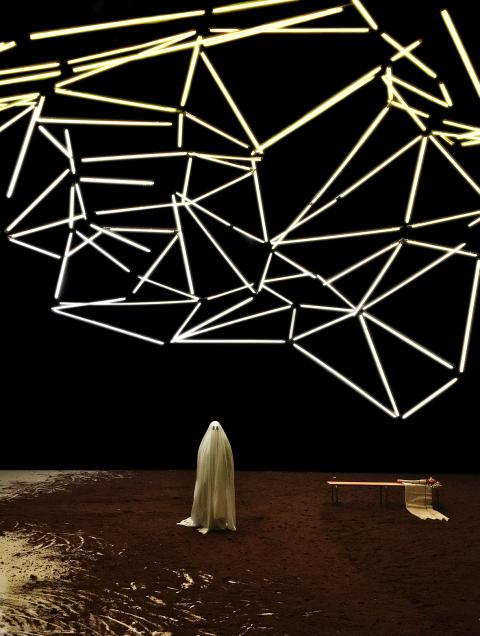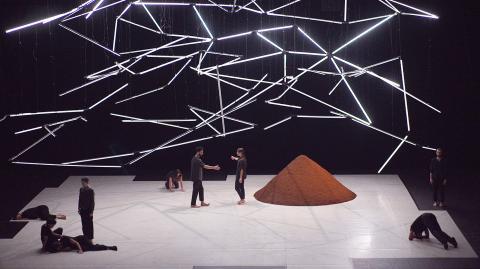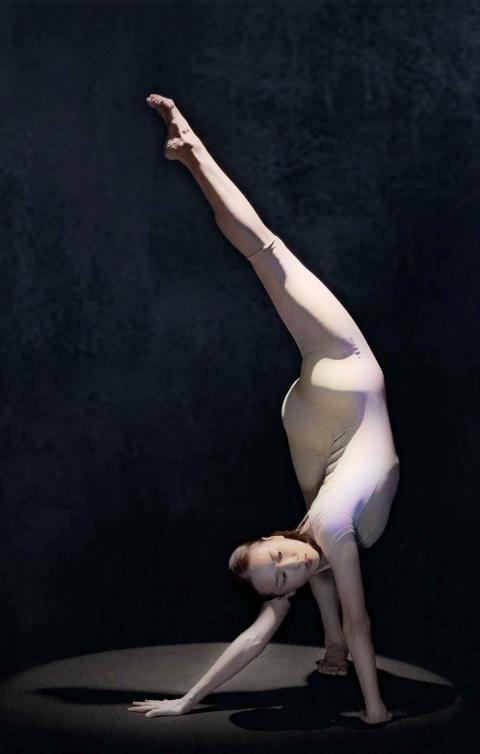Two programs in Taipei this weekend as part of the Taiwan International Festival of Arts aim to explore the world of dance in an evolving landscape, one that seeks to bring the universe inside the National Theater, while the other will draw inspiration from its outdoors settings.
The creators are two men well known to dance audiences in Taiwan: Frenchman Christian Rizzo, artistic director of ICI-CCN Montpellier and a frequent visitor to this nation, and Taiwanese choreographer Su Wei-chia (蘇威嘉), one of the cofounders of the Horse (驫舞劇場) dance collective.
Rizzo, who was last year awarded the Taiwan-France Cultural Award by the Ministry of Culture, can date his affair with Taiwan to his residencies at the Taipei Artist Village (台北國際藝術村) in 2006 and 2007, which were followed by a collaboration with Dance Forum Taipei (舞蹈空間) in 2008 at the Experimental Theater, How to say “Here”? and in 2012, b.c, janvier 1545, Fontainebleau for National Theater Concert Hall’s (NTCH) Dancing into Autumn series.

Photo courtesy of Lin I-chu / National Theater Concert Hall
His TIFA track record includes Based on a True Story (d’apres une histoire vraie) at the National Theater in 2016, and AD NOCTUM at the National Taichung Theater in April last year.
The 54-year-old started off by studying visual art, and was a rock musician and a clothing designer before turning to dance, and his productions reflect the multiplicity of his interests.
He is credited with the choreography, stage and costume design and the light “objects” for his latest production, une maison, which will have its Taiwan premiere tomorrow night.

Photo courtesy of Lin I-chu / National Theater Concert Hall
The show remains something of a mystery as of press time. Coproduced by the NTCH and more than a dozen theaters and cultural centers in Europe, rehearsals began in September last year and have continued right up until this week, despite the show’s French premiere on March 5 at the Bonlieu Scene nationale in Annecy.
No press conference was scheduled for this week, and photographic evidence has been scant, according to NTCH staffers. However, the show is already is scheduled for performances in France, Portugal, Spain and Belgium that will keep it on tour through April next year.
In his initial media interviews, Rizzo said he wanted to draw the profile of “a house” with dance from a place we call “house,” reflecting that the place humans call home, Earth, is but one small part of a universe with billions of galaxies and that our homes are not only concrete entities, but contain the mental and physical memories of our existence and connections.

Photo courtesy of National Theater Concert Hall
Fourteen dancers carry the outlines or tracks of 14 houses as they meet, connect, part and meet again.
“There are multiple length lives. Each time there is the re-taming of silence in order to see the calm within signs of storm,” Rizzo wrote in the production notes.
While Rizzo’s cast is building their universe inside, Su’s team will be outside with the latest installation of his Free Steps (自由步) series, which will be performed for free.
Su is now in the sixth year of the 10-year project that focuses on variations in physical shapes, steps, rhythms and shadows to create an evolving physical sculpture and a celebration of the body in motion.
It grew out of his participation in the 2013 ArtsCross program in London, an exchange project that brought together dancers and choreographers from Middlesex University Taipei National University of the Arts (TNUA, 國立臺北藝術大學) and the Beijing Dance Academy, although its origins date back to his master’s degree graduation project and thesis, Exploring Dance from Tracing and Discovering (FREE STEPS).
Su has had a lot of support from the NTCH over the years for the project, including having earlier versions presented as part of the 2015 Innovation Series-Dance and 2017’s TIFA and being the National Performing Arts Center-National Theater and Concert Hall artist-in-residence in 2016.
That support has been well worth it, for each installation has been a revelation in terms of dance and of Su’s development as a choreographer and collaborator with other artists.
Su tinkered with his short ArtsCross presentation for TNUA’s winter dance concert in December of that year, and in 2015 presented the first full length work from the project, FreeSteps at the National Experimental Theater 2015, a piece set on six women and one man. The following year, the installation was a mesmerizing duet for two women, shown as part of the Taiwan Dance Platform at the Weiwuying National Kaohsiung Center for the Arts.
In 2017, Su returned to the Experimental with Free Steps (自由步—身體的眾生相), a collection of solos created for follow Horse cofounders Chen Wu-kang (陳武康) and Chou Shu-yi (周書毅).
This newest version, Free Steps — NiNi (自由步—盞燈的景身), is a 40-minute solo set on dancer Fang Yu-ting (方妤婷) that seeks to break down the barriers between choreography, performance and audiences.
He said he wanted to create a piece where all of the elements, from the weather, the lighting, the landscape and other people become material for the dance.
As with the previous versions, Taiwan-based French sound designer Yannick Dauby created the score and Liu Chia-ming (劉家明) the lighting design.
Fang will perform tomorrow on main plaza between the two halls, Saturday at 6pm in the plaza at the Exit 5 of Chiang Kai-shek Memorial Hall MRT Station, Friday next week at 6pm on the Concert Hall terrace and the following day at 6pm in the Forest Playland near the Concert Hall.
On April 13 and April 14 she will perform in the Crown Hall at Weiwuying National Kaohsiung Center for the Arts.
The performances in Taipei will be 40 minutes each, but at Weiwuying they will be just 20 minutes.

In the March 9 edition of the Taipei Times a piece by Ninon Godefroy ran with the headine “The quiet, gentle rhythm of Taiwan.” It started with the line “Taiwan is a small, humble place. There is no Eiffel Tower, no pyramids — no singular attraction that draws the world’s attention.” I laughed out loud at that. This was out of no disrespect for the author or the piece, which made some interesting analogies and good points about how both Din Tai Fung’s and Taiwan Semiconductor Manufacturing Co’s (TSMC, 台積電) meticulous attention to detail and quality are not quite up to

April 21 to April 27 Hsieh Er’s (謝娥) political fortunes were rising fast after she got out of jail and joined the Chinese Nationalist Party (KMT) in December 1945. Not only did she hold key positions in various committees, she was elected the only woman on the Taipei City Council and headed to Nanjing in 1946 as the sole Taiwanese female representative to the National Constituent Assembly. With the support of first lady Soong May-ling (宋美齡), she started the Taipei Women’s Association and Taiwan Provincial Women’s Association, where she

Chinese Nationalist Party (KMT) Chairman Eric Chu (朱立倫) hatched a bold plan to charge forward and seize the initiative when he held a protest in front of the Taipei City Prosecutors’ Office. Though risky, because illegal, its success would help tackle at least six problems facing both himself and the KMT. What he did not see coming was Taipei Mayor Chiang Wan-an (將萬安) tripping him up out of the gate. In spite of Chu being the most consequential and successful KMT chairman since the early 2010s — arguably saving the party from financial ruin and restoring its electoral viability —

It is one of the more remarkable facts of Taiwan history that it was never occupied or claimed by any of the numerous kingdoms of southern China — Han or otherwise — that lay just across the water from it. None of their brilliant ministers ever discovered that Taiwan was a “core interest” of the state whose annexation was “inevitable.” As Paul Kua notes in an excellent monograph laying out how the Portuguese gave Taiwan the name “Formosa,” the first Europeans to express an interest in occupying Taiwan were the Spanish. Tonio Andrade in his seminal work, How Taiwan Became Chinese,